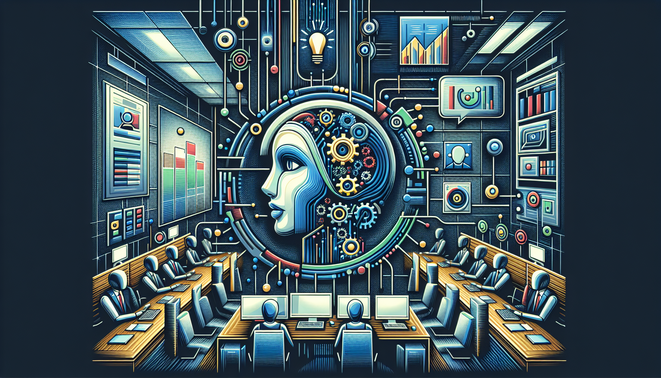Physical Address
304 North Cardinal St.
Dorchester Center, MA 02124
Physical Address
304 North Cardinal St.
Dorchester Center, MA 02124

Understanding AI Chatbots in Enterprise Environments
Meta Summary: Dive into the world of AI chatbots and their transformative impact on enterprises. Explore key players like ChatGPT, Claude, and Bard, and learn how to evaluate their performance, customization, and integration.
In today’s digital-first world, AI chatbots are revolutionizing how businesses interact with customers and manage internal processes. These AI-powered programs are designed to simulate conversations with users, offering functionalities from customer support to personalized marketing. As enterprises increasingly adopt AI chatbots, understanding their capabilities, performance, and integration options becomes crucial.
Introduction to AI Chatbots
AI chatbots are indispensable tools in enterprise environments. They handle customer inquiries, automate repetitive tasks, and enhance user engagement. Leveraging advanced algorithms, they understand and process human language, providing responses that are increasingly indistinguishable from those of human operators.
Learning Objectives
Understand the basics of AI chatbots and their role in enterprise environments: AI chatbots streamline operations, enhance customer satisfaction, and drive sales.
Identify key features that differentiate AI chatbots in the market: Features such as natural language processing, machine learning capabilities, and integration flexibility set chatbots apart.
AI chatbots boast advantages like 24/7 availability, reduced operational costs, and the ability to handle large volumes of interactions. Advancements in AI have led to chatbots that learn from interactions, improving over time without manual intervention.
Overview of ChatGPT, Claude, and Bard
ChatGPT, Claude, and Bard are frontrunners in AI chatbots, each offering unique architectures and functionalities.
Learning Objectives
Compare the architectures of ChatGPT, Claude, and Bard: Understanding distinct technologies aids in evaluating performance and capabilities.
Discuss the unique functionalities offered by each chatbot: This knowledge is crucial for selecting the right chatbot for specific business needs.
ChatGPT
Developed by OpenAI, ChatGPT is renowned for conversational abilities and adaptability. Its transformer-based architecture allows it to generate human-like text and handle complex dialogues.
Claude
Claude, developed by Anthropic, prioritizes safety and ethical AI interactions. Designed to ensure user safety and reduce harmful outputs, it’s ideal for industries where compliance is crucial.
Bard
Google’s Bard excels with integration within Google’s ecosystem, providing seamless access to Google’s data and services. It’s particularly beneficial where integration with Google services is advantageous.
Performance Metrics for Enterprise Use
Evaluating AI chatbots’ performance in enterprises involves assessing accuracy, speed, and user satisfaction.
Learning Objectives
Evaluate the accuracy of different chatbots in enterprise scenarios: Accuracy is vital for delivering correct and reliable information.
Analyze user feedback data on chatbot performance: User feedback offers insights into practical effectiveness.
Case Study
A tech company employed ChatGPT for customer support inquiries, achieving a 30% reduction in response time. This shows how metrics like response time significantly impact customer satisfaction and efficiency.
Exercises
Analyze a dataset of user interactions to compare accuracy metrics: Understand chatbot performance across various scenarios.
Simulate a performance evaluation through role-play: Role-play highlights practical performance issues and areas needing improvement.
Best Practices
Update and train chatbots regularly on new data to enhance accuracy: Continuous learning maintains high performance.
Ensure detailed documentation for all integrations and customizations: Proper documentation facilitates smoother operations and troubleshooting.
Tip: Regularly collecting user feedback is essential for ongoing improvement.
Pitfalls
Neglecting user feedback assessment can lead to unnoticed performance issues.
Assuming one-size-fits-all solutions compromises customization benefits.
Customization Capabilities
Customization allows businesses to tailor chatbots to meet specific needs, enhancing their utility and performance.
Learning Objectives
Assess flexibility and customization options for each chatbot: Align functionalities with business objectives through customization.
Identify use cases where customization enhances performance: Tailored solutions significantly influence outcomes.
Case Study
An e-commerce business used Claude to create tailored product recommendation systems, increasing sales by 25%. This showcases customization’s direct impact on business outcomes.
Integration and Deployment Options
Successful AI chatbot implementation heavily relies on integration with existing systems and deployment strategies.
Learning Objectives
Review integration frameworks compatible with each chatbot: Understanding options ensures seamless function within ecosystems.
Examine cloud deployment considerations and strategies: Cloud deployment offers scalability and accessibility, crucial for modern enterprises.
Exercises
Integrate a chatbot with a CRM system using APIs: Gain hands-on experience with integration challenges and solutions.
Design a cloud deployment strategy considering scalability: Planning growth and demand fluctuations is essential.
Best Practices
Continuously monitor chatbot performance to identify areas for improvement: Regular monitoring ensures continued effectiveness.
Conclusion and Recommendations
Learning Objectives
Summarize strengths and weaknesses of each AI chatbot: Comprehensive understanding helps make informed decisions.
Provide actionable recommendations based on business needs: Tailored recommendations ensure effective chatbot leverage.
ChatGPT, Claude, and Bard each offer distinct advantages. ChatGPT excels in conversational abilities, Claude prioritizes safety, and Bard integrates seamlessly with Google services. Business choices should consider integration requirements, customization potential, and performance metrics.
Visual Aids Suggestions
Architecture diagram comparing ChatGPT, Claude, and Bard: Aids in understanding structural differences.
Flowchart illustrating integration process with existing systems: Simplifies integration steps.
Key Takeaways
AI chatbots are pivotal in modern enterprises for enhancing interactions and efficiency.
Understanding architectures and functionalities of ChatGPT, Claude, and Bard aids in selecting suitable chatbots.
Metrics, customization capabilities, and integration options are keys to effective deployment.
Glossary
AI Chatbot: AI-powered program simulating conversation with users.
Customization: Tailoring chatbot to specific business needs.
Integration: Connecting the chatbot with other systems.
Cloud Deployment: Hosting chatbot services on cloud infrastructure for scalability and accessibility.
Knowledge Check
What are the main differences in architecture between ChatGPT, Claude, and Bard?
a) They use different programming languages.
b) They have different user interfaces.
c) They are built on different AI architectures.
d) They operate in different geographic regions.
Explain how integration strategies vary among the three chatbots.
(ShortAnswer)
Further Reading
ChatGPT Research by OpenAI
Anthropic’s Claude Technology Overview
Google’s Bard Overview
This comprehensive exploration of AI chatbots equips you with knowledge to navigate the evolving landscape of digital interactions, ensuring your enterprise remains competitive and customer-focused.